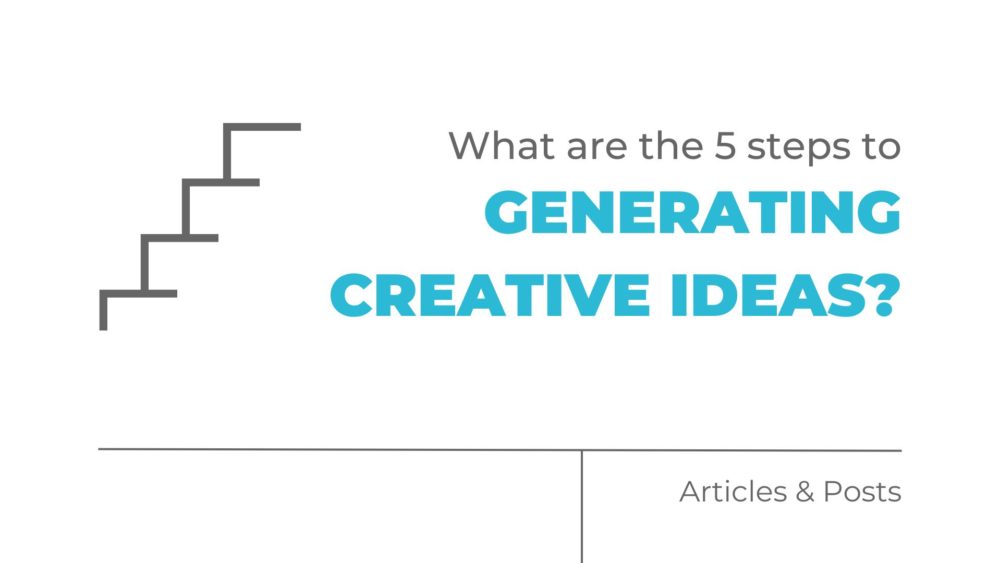In the world of creative marketing and design, generating fresh and innovative ideas is crucial for success.
But how exactly does the creative process work? (This is something we love sharing about in our podcast.)
Where does it come from, and how can we leverage it to generate ideas that captivate our audience?
In this blog post, we will explore the five key steps to generating creative ideas and their specific relevance to the realms of creative marketing and design.
The Process of Creativity
Creativity is not a random phenomenon; rather, it follows a structured process that involves a series of distinct stages.
The five-step creative process is often attributed to psychologist and creative expert James Webb Young, who detailed it in his book “A Technique for Producing Ideas”.
The process, designed to stimulate thought and encourage the generation of unique ideas, has roots in the theories and practices of creative thinkers and leaders across various disciplines.
Young believed that by understanding this process, anyone could train their mind to consistently produce innovative ideas.
The five steps have been widely accepted and adopted in many fields, including creative marketing and design, for their effectiveness and practicality.
Understanding these stages can help us navigate through the creative process more effectively.
Let’s look more at each step and explore its significance:
Preparation in the Creative Process
The first step in generating creative ideas is preparation.
This stage involves immersing yourself in the subject matter, conducting research, and gathering relevant information.
By arming yourself with a solid understanding of the topic at hand, you lay the groundwork for inspiration and originality.
In creative marketing and design, thorough preparation ensures that your ideas are rooted in a deep understanding of the target audience, industry trends, and the brand’s unique value proposition.
This is how you set yourself up to succeed.
Incubation in the Creative Process
After the preparation stage, comes incubation.
This phase involves stepping away from the problem at hand and allowing your mind to wander.
During this period, your subconscious mind continues to process the information gathered during preparation, making connections and associations that may lead to breakthrough ideas.
Taking breaks, engaging in activities unrelated to the task, and giving yourself mental space are essential components of the incubation stage.
In creative marketing and design, allowing time for incubation can yield unexpected and ingenious solutions to complex problems.
Illumination in the Creative Process
The illumination stage, often referred to as the “aha moment,” is when the creative spark ignites.
It is the moment of insight when the solution or idea becomes clear.
This stage is characterized by a sudden burst of inspiration and excitement.
In creative marketing and design, illumination can manifest in the form of a captivating campaign concept, a unique visual design, or a compelling messaging angle.
Embracing this moment of illumination and capturing it effectively is key to translating ideas into impactful creative executions.
Evaluation in the Creative Process
Once the initial inspiration strikes, it’s important to subject your ideas to rigorous evaluation.
The evaluation stage involves critically analyzing the feasibility, relevance, and effectiveness of the generated ideas.
This step requires a careful balance of open-mindedness and objectivity, as it ensures that only the most promising ideas move forward.
In creative marketing and design, evaluation helps filter out impractical ideas and refine those with the highest potential to resonate with the target audience.
Verification in the Creative Process
The final step in the creative process is verification.
This stage involves validating the selected ideas through testing, feedback, and refinement.
By gathering insights from peers, clients, or target audience members, you can fine-tune your ideas and ensure they align with the desired objectives.
Verification allows you to iterate and improve upon the initial concepts, leading to stronger and more impactful creative outcomes.
In creative marketing and design, verification enables you to optimize ideas for maximum engagement and effectiveness.
Conclusion
Understanding the five steps to generating creative ideas provides a roadmap for keeping the creative process alive and growing in the realms of creative marketing and design.
By embracing preparation, incubation, illumination, evaluation, and verification, marketers and designers can unlock their full creative potential and deliver exceptional results.
So, the next time you find yourself seeking inspiration, remember these steps and embark on a journey of creativity that will captivate your audience and elevate your work to new heights.


Comments are closed.